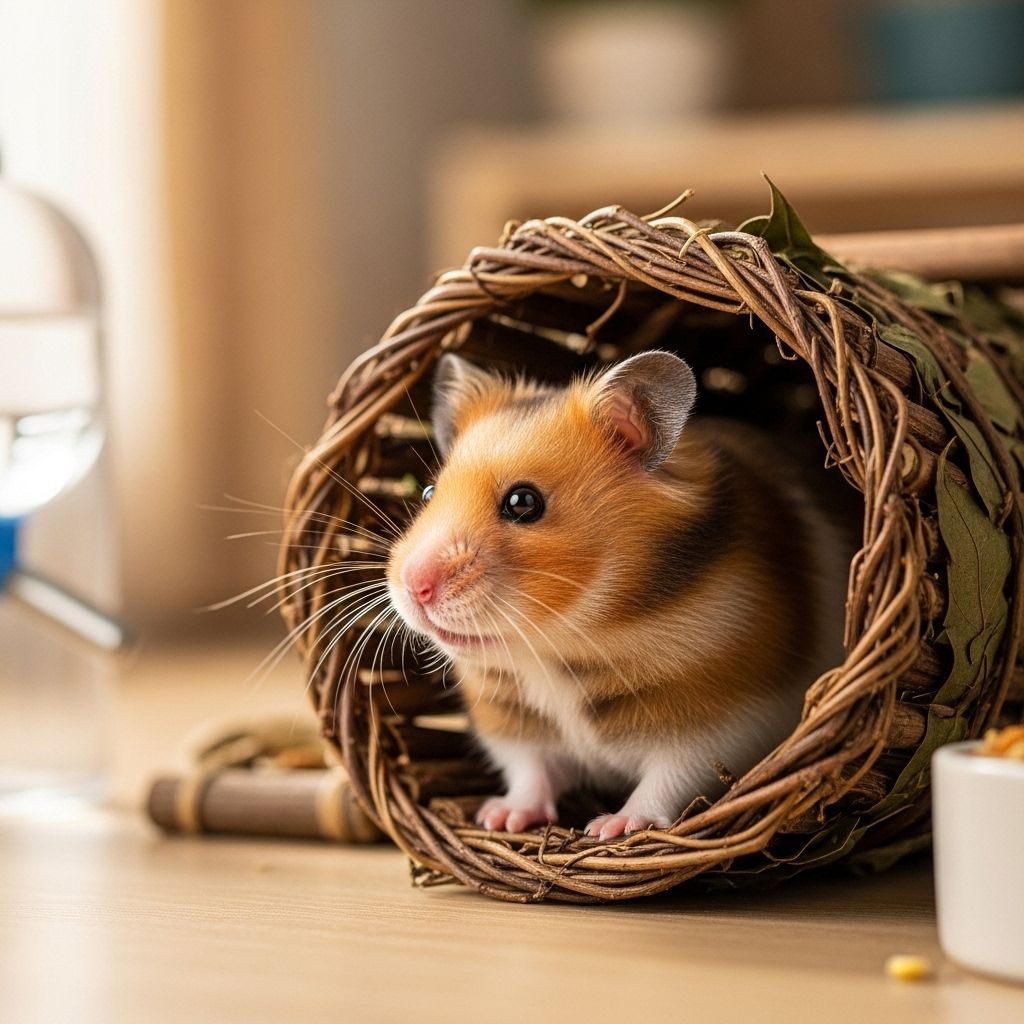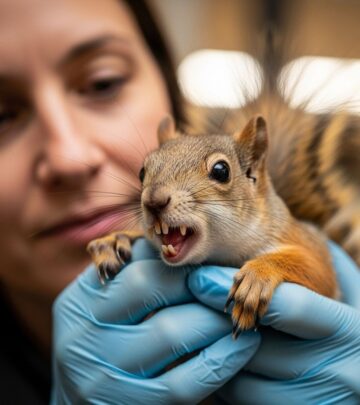Hamster Lifespan: Guide To Species, Aging & Essential Care Tips
Discover the lifespan of different hamster breeds, expert care tips, health signs, and what to expect as your hamster ages.

Image: HearthJunction Design Team
How Long Do Hamsters Live? Lifespan, Species, Aging, and Essential Tips
Hamsters are beloved small pets prized for their playful personality, resilience, and adorable features. Yet, any owner or potential adopter must understand that hamsters have relatively short lifespans compared to other pets. This comprehensive guide explores hamster longevity, species differences, factors affecting their lives, signs of aging, and expert advice for ensuring your furry companion enjoys a happy, comfortable life.
Quick Facts: Hamster Life Expectancy
- Most pet hamsters live between 1.5 and 3 years.
- Lifespan varies by species, care quality, genetics, and environment.
- Hamsters are considered elderly at 1.5 years old.
- Their short lifespan makes them both a gentle lesson in animal care and the natural lifecycle for children and first-time owners.
Meet the Hamster: Species Differences
There are over 24 recognized hamster species, though only a few are commonly kept as pets. Each species presents distinct personality traits, sizes, and average lifespans.
| Species | Common Names | Typical Size | Average Lifespan |
|---|---|---|---|
| Syrian Hamster | Teddy Bear, Golden | 5-7 inches | 2-4 years |
| Roborovski Hamster | Robo | 1.5-2 inches | 3+ years |
| Campbell’s Dwarf Russian | Dwarf | 2-4 inches | 1.5-2 years |
| Siberian / Winter White | Djungarian | 2-4 inches | ~2 years |
| Chinese Hamster | Chinese Dwarf | 3-5 inches | 2-3 years |
Syrian Hamster
The Syrian hamster is the largest and arguably the most popular pet hamster. Recognized by its golden coat and adorable ‘teddy bear’ look, it tends to live between 2 and 4 years when properly cared for. Syrians are solitary and must be housed alone for safety and well-being.
Dwarf Hamster Varieties
- Roborovski Hamster: The smallest and often longest-lived of the dwarfs, Roborovski hamsters commonly reach up to 3 years or slightly more with excellent care.
- Campbell’s Dwarf Russian: These hamsters are sociable in pairs (if introduced young) and average about 1.5 to 2 years.
- Siberian (Winter White): Known for changing fur color in winter, these hamsters generally live around 2 years on average.
- Chinese Hamster: With a slender body and longer tail, the Chinese hamster’s lifespan averages around 2 to 3 years.
Wild vs. Pet Hamster Lifespan
Interestingly, wild hamsters sometimes outlive their domesticated relatives—though only if they evade predators. The European hamster, for example, can potentially reach up to eight years in the wild. Pet hamsters, by contrast, tend to live shorter lives, usually between 1.5 to 4 years, influenced by their breed and the conditions of their care.
Factors That Affect Hamster Lifespan
While genetics and species set a baseline, several key factors play a critical role in determining how long your hamster might live:
- Breed & Origin: Dwarf breeds may live slightly longer than Syrians, but longevity varies by individual genetics.
- Diet: Proper nutrition with fresh fruits, veggies, and high-quality hamster chow supports long-term health.
- Environment: Clean, spacious enclosures reduce stress and disease risk.
- Exercise: Wheels, toys, and tunnels promote healthy activity, mental stimulation, and a lean body.
- Social Setting: Some species (e.g., Syrians) are best kept alone to avoid fighting and injury, while some dwarfs tolerate carefully managed pairing.
- Veterinary Care: Early intervention for illness, regular checkups, and prompt dental/nail care extend lifespan.
- Stress Levels: Loud noise, excessive handling, or constant cage rearrangement can harm your hamster’s health and longevity.
Common Health Issues and Signs of Aging
Hamsters age quickly, making it essential to know the signs of aging and common health concerns. Early detection and appropriate care can often improve their remaining quality of life.
- Wet Tail: A bacterial infection causing diarrhea—urgent veterinary attention is needed.
- Overgrown Teeth: Hamsters’ teeth grow continuously; they need chew toys and regular checks.
- Bite or Cage Injuries: Prevent by housing appropriately and monitoring for aggression, especially with multiple animals.
- Obesity or Weight Loss: Sudden weight changes can signal illness or malnutrition.
- Reduced Activity: Senior hamsters may sleep more, move less, or develop joint stiffness.
- Hair Loss & Skin Issues: Thinning fur, sores, or irritated skin may occur as they age.
- Eye & Ear Changes: Elderly hamsters might develop cataracts, discharge, or hearing loss.
On average, hamsters reach old age around 1.5 years. The average age at death for pet hamsters is about 1.75 years (21 months), though many comfortably reach 2–3 years, especially with attentive care.
Tips for Helping Your Hamster Live a Longer, Healthier Life
While you cannot control genetics, you can dramatically influence your hamster’s well-being through thoughtful husbandry:
- Provide a large, well-ventilated cage with safe bedding and enrichment.
- Change bedding regularly to prevent respiratory issues.
- Offer a balanced diet rich in protein, fresh grains, seeds, and washed fruits or veggies (in moderation).
- Always provide fresh, clean water in a sipper bottle or bowl.
- Ensure your hamster has daily opportunities to exercise on a wheel and explore outside its cage (in a secure playpen).
- Minimize stress by keeping handling gentle and routine predictable.
- Keep the cage away from direct sunlight, drafts, and loud noises.
- Check your hamster weekly for signs of illness, focusing on weight, coat, teeth, and behavior.
- Consult a veterinarian specializing in small animals at the first signs of discomfort, injury, or behavioral changes.
How to Recognize When Your Hamster Is Getting Old
Being able to spot signs of aging gives you the chance to adjust your care and provide comfort as your hamster enters its senior years. Watch for:
- Decreased energy or sleeping more than usual
- Noticeable tremors or unsteady gait
- Thinning fur, especially around the face and rear quarters
- Weight loss and bony appearance
- Changes in eating, drinking, or bathroom habits
- Increased susceptibility to infections or tumors
If you observe any concerning symptoms, consult your veterinarian. Some conditions are treatable, while others are simply part of natural aging. Supportive care, a soft bed, easily accessible food and water, and gentle handling help make your hamster’s final months comfortable.
Children, Families, and the Hamster’s Lifespan: What to Know
Because hamsters typically live less than four years, they provide an opportunity for teaching children about animal care, compassion, and the natural life cycle. Prepare your household for the reality that your furry friend will not be around as long as some other pets, and celebrate the time you share together. Open, age-appropriate discussions about illness and loss can help children process these important lessons in a supportive environment.
Frequently Asked Questions About Hamster Lifespans
How long do different hamster breeds live?
Syrians typically live 2–4 years, Roborovski 3 or more years, Chinese 2–3 years, and most dwarf varieties about 1.5–2 years. Individual longevity depends on care and environment.
What can I do to help my hamster live longer?
Feed a balanced diet, provide a clean and enriching home, ensure plenty of exercise, minimize stress, and attend regular vet checkups. Watch for signs of illness and respond promptly.
How do I know if my hamster is getting old?
Look for signs such as less activity, longer naps, thinning fur, weight loss, and changes in appetite or behavior. Consult a vet if you notice sudden changes.
Is it true that hamsters live longer in the wild?
Some wild species may live longer if they avoid predation and disease, but pet hamsters often benefit from medical care and stable diets, which can also contribute to longevity.
Can multiple hamsters live together?
Most hamsters, especially Syrians, are solitary by nature and should be kept alone. Some dwarf species tolerate cage mates but require careful introduction and monitoring to prevent fights and injuries.
Conclusion: Cherishing Your Hamster’s Time
While the hamster’s lifespan is short compared to other pets, with attentive care, proper nutrition, and regular health checks, you can ensure your furry friend enjoys a high quality of life. Celebrate each day together, and remember: even the smallest pets leave the biggest pawprints on our hearts.
References
- https://www.petmd.com/exotic/general-health/how-long-do-hamsters-live
- https://www.rspca.org.uk/adviceandwelfare/pets/rodents/hamsters
- https://www.carecredit.com/well-u/pet-care/hamster-lifespan/
- https://www.rvc.ac.uk/vetcompass/news/largest-study-reveals-most-common-disorders-and-lifespan-of-pet-hamsters-in-the-uk
- https://www.petsradar.com/advice/how-long-do-hamsters-live
Read full bio of Anjali Sayee












